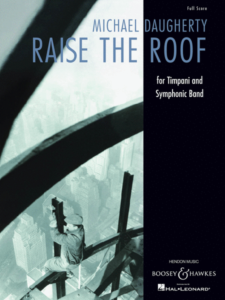Raise the Roof
for timpani and symphonic band (2007)
Instrumentation: Solo timpani with cymbal; 5 flutes (V=piccolo), 2 oboes, English horn, 4 clarinets, Eb clarinet, bass clarinet, 2 bassoons, contrabassoon; 2 alto saxes, tenor sax, baritone sax; 4 horns, 3 trumpets, 3 trombones, 2 euphoniums, 2 tubas; 6 percussion (I=xylophone/glockenspiel; II=vibraphone; III=marimba; IV=glockenspiel/large finger cymbals/chimes/metal plate/suspended cymbal/crash cymbals; V=claves/small tambourine/suspended cymbals/metal plate; VI=large bass drum/medium tambourine/cabasa); piano; 2 double basses
Publisher: Boosey and Hawkes, Hendon Music (BMI)
Duration: 13 minutes
World Premiere: March 30, 2007 / Hill Auditorium in Ann Arbor, Michigan / National Conference of the College Band Directors National Association / University of Michigan Symphony Band / Michael Haithcock

Program Note:
Raise the Roof (2007) for timpani and symphonic band was commissioned and premiered by the University of Michigan Symphony Band. The world premiere was performed by the University of Michigan Symphony Band, conducted by Michael Haithcock, at the National Conference of the College Band Directors National Association, at Hill Auditorium in Ann Arbor, Michigan, on March 30, 2007. Raise the Roof is inspired by the construction of grand architectural wonders such as the Notre Dame Cathedral (1345) in Paris and the Empire State Building (1931) in New York City. I create a grand acoustic construction by bringing the timpani into the foreground and giving the timpanist the rare opportunity to play long expressive melodies, and a tour de force cadenza. I incorporate a wide variety of timpani performance techniques: extensive use of foot pedals for melodic tuning of the drums, placement of a cymbal upside down on the head of the lowest drum to play glissandi rolls, and striking the drums with regular mallets, wire brushes, maraca sticks, and even bare hands. Raise the Roof is in the form of a double variation. The first theme of the double variation, played initially by the tuba, is presented in various timbral and rhythmic guises such as “guaguanco.” The second theme of the double variation, first heard in the flutes and then the timpani, is reminiscent of a medieval plain chant. The two themes are passed around in canons and fugues and other permutations throughout the ensemble to create elaborate patterns, as in a gothic cathedral. Raise the Roof rises toward a crescendo of urban polyrhythms and dynamic contrasts, allowing the timpani and the symphonic band to create a grand acoustic construction.
–Michael Daugherty
